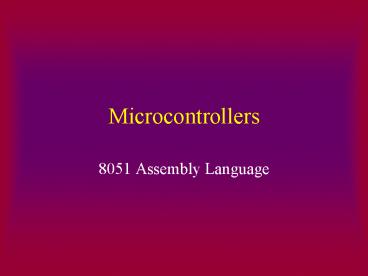Microcontrollers - PowerPoint PPT Presentation
1 / 27
Title: Microcontrollers
1
Microcontrollers
- 8051 Assembly Language
2
What can the 8051 instructions do?
- Arithmetic (add, subtract, multiply, divide)
- Logical Operations (AND, OR, NOT, etc.)
- Data Transfer (move bytes)
- Boolean Variable Manipulation (move bits)
- Program Branching (branch, call subroutines)
3
Why does the uP need registers?
- Scratch pad.
- Math.
- Interface with the outside world.
- Timing and counting.
- Keep track of the program and interpret
instructions. - Point to data by holding addresses for easy
reference.
4
128 Bytes of On Chip RAM
Lower 64 Bytes
Upper 64 Bytes
5
Scratch Pad on Chip RAM
80 byte addressable registers
128 addressable bits
32 register (Rn) addressable bytes
6
The 4 Register Banks.
Numbered 0,1,2, and 3Only 1 at a time can be
activatedBank 0 is the default bank.
Rn
1 byte per register
Ri
7
The Special Function Register Map
(upper 64 bytes of on chip RAM)
Mnemonic Address
Byte Address
Bit Address
8
MOV dest-byte, source-byteCopies bytes from the
source to the destination.
- MOV A, data
- MOV A, Rn
- MOV A, direct
- MOV A, _at_Ri
- MOV Rn, A
- MOV direct, A
- MOV _at_Ri, A
- MOV Rn, data
- MOV Rn, A
- MOV Rn, direct
- MOV direct, data
- MOV direct, _at_Ri
- MOV direct, Rn
- MOV _at_Ri, data
- MOV _at_Ri, A
- MOV _at_Ri, direct
9
direct addressing
- direct any 8 bit address 00H to FFH.
- 2 byte instruction
- Can be used for any 8-bit address
- Example MOV A, 45H
- Copies the contents of RAM location 45H into the
accumulator. - Direct addresses may not start with a letter so
use a leading zero as in 0E0H instead of E0H.
10
Immediate (data) addressing
- data 8-bit number 00H to FFH.
- 10010110B (a binary number)
- 76H ( a hexadecimal number)
- 118 ( a decimal number)
- Example MOV A, 76H
- Makes the contents of the accumulator become 76H
- Data may not begin with a letter. Use a leading
zero as in 0E0H instead of E0H.
11
Register Addressing
- Rn any register in the selected register bank.
(n 0,1,2,3,4,5,6,7)
12
Indirect Addressing
- _at_Ri register 0 or register 1 in the selected
register bank. ( i 0,1 only) - Ri contains the address of the data.
13
ADD A, source-byte
- Accumulator is always the destination byte.
- If there is a carry from E7, CY goes high.
- If there is an overflow, OV goes high.
- Direct addressing as in ADD A, 7FH
- Immediate addressing as in ADD A. 7FH
14
The Stack
- The Stack is a continuous group of RAM memory
locations. - By default, the stack starts at 08H in RAM (Bank
1) and may extend to RAM address 7FH. - Uses the PUSH and POP instructions.
- PUSH places data on the stack
- POP takes data from the stack
15
PUSH direct
- Example PUSH 0E0H
- Execution
- First, the stack pointer is incremented (1 is
added). - Second, the contents of RAM memory location E0H
is copied to the address indicated by the stack
pointer.
16
POP direct
- Example POP 0E0H
- First the contents of the memory location
indicated by the stack pointer is copied into RAM
memory location E0H. - Second, the stack pointer is decremented (1 is
subtracted).
17
The programming process
18
.asm files
- Called the source code.
- Written in mnemonic form
- Created with software that is essentially a
simple word processor. - Keyboard entry.
19
.obj files
- Called theobject file.
- The output of the assembler.
- In a format called the machine language
20
.lst file
- Lists all the opcodes, operands, and addresses.
- Lists all of the programming syntax errors.
21
Library files
- Can include any boilerplate code and often used
subroutines.
22
.abs files
- Called the absolute file.
- A marriage of all .obj files that have been
linked together.
23
.hex file
- Machine code that appears in hexadecimal form.
- Can be loaded into a ROM burner for programming
the ROM chip.
24
DB directive
- The DB directive tells the assembler that the
8-bit number that follows is constant data and
not an instruction. - Example DB 28 causes 1CH to be stored in ROM .
25
ORG directive
- Indicates the beginning address at which the
program will be placed in ROM.
26
EQU directive
- Assigns a literal name to to a number.
- Example THIS_YEAR EQU 2002
- Before assembly, the number 2002 will replace
every instance of THIS_YEAR in the program.
27
END directive
- Indicates the last line of the source code.






























